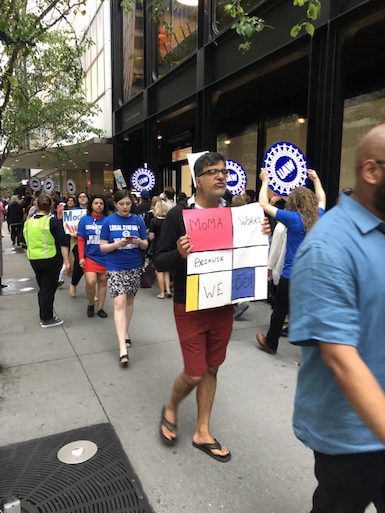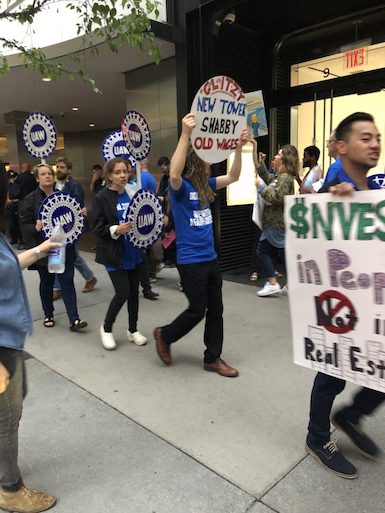[ad_1]

The demonstration outside the Museum of Modern Art in New York on Wednesday evening.
ANDREW RUSSETH/ARTNEWS
The skyscrapers in Midtown Manhattan were disappearing into thick, gray clouds last night as office workers headed toward subway entrances and jumped into taxis. Outside the Museum of Modern Art on West 53rd Street, black cars and hulking SUVs dropped off guests at the Museum of Modern Art for its Party in the Garden, an annual fundraising gala that this year honored patron Agnes Gund, a president emerita of MoMA and chairman of MoMA PS1’s board.
Near the museum’s entrance, dozens of MoMA workers were also on hand, calling on the museum to meet its demands in ongoing negotiations over a new contract. (The previous one expired last month.) They walked in a loop and held placards for the UAW, which represents many of the museum’s employees, from curators and educators to librarians and editors. Some had made their own signs, which read “$NVEST in People Not in Real Estate” or “MODERN ART ANCIENT WAGES,” or simply presented a depiction of Edvard Munch’s The Scream, a version of which the newly minted MoMA chairman Leon Black purchased for almost $120 million for in 2012.
The mood was buoyant for the Party on the Pavement, as the union, Local 2110, had dubbed the event. A tall stack of pizza was on offer, and architectural historian Kenneth Frampton—fresh off receiving the Golden Lion for Lifetime Achievement at the current Venice Architecture Biennale—had stopped by early in the evening and posed for a photo holding a blue union shirt. The members’ chanting was vigorous, their phrases punctuated by whistle blows: “Get up, get down! New York is a union town!”
There are a number of points of disagreement with MoMA leadership, according to union members, including the size of annual wage increases, how overtime is handled, lack of job security for some employees, an effort by the museum to eliminate a program that provides pay bumps after certain years of employment, and rising health care costs.

The demonstration outside the Museum of Modern Art in New York on Wednesday evening.
ANDREW RUSSETH/ARTNEWS
“We don’t think that an institution like MoMA is incapable of helping us in that regard,” Maria Marchenkova, an assistant editor in MoMA’s department of publications who is involved in the negotiations, said, speaking about the museum’s health care policies. “It’s an institution with a lot of money, so we don’t buy the idea that their expenses have gone up astronomically and therefore they need to pass them onto us. We’re just not buying that.” (The museum is currently completing a $400 million expansion, the union has noted.)
While an issue like the cost of health care affects all of the country, Marchenkova said, MoMA presents itself as a progressive institution—for instance, by “challenging the Trump administration” by hanging works made by artists from countries affected by the first travel ban. “We think that’s at odds with them trying to decrease people’s wage increases,” she said, “not helping them with basic health care and other life issues, and exploiting the staff through overtime.”
In a statement made following the demonstration, a museum spokesperson said, “MoMA’s extraordinary staff are the best in the world. We are committed to working with the Local 2110 to reach an agreement that will keep our community of dedicated staff and the museum on a path of financial stability and future growth. We respect the right of each individual to contribute to the open dialogue and make her or his voice heard in this process.”
Three years ago, union members were also on hand for the Party in the Garden as the union lobbied for a new contract, and so the demonstration is becoming an irregular tradition of sorts. “We don’t want to ruin the night for anyone, because this is a fundraising event that ultimately benefits everybody who works here,” Marchenkova continued, “but we just want to highlight that there are all these things going on behind the scenes.”
It was about half past 7 p.m., and guests were still passing by the marchers—curators from various New York museums, Frank Stella, natty businesspeople. Some snapped pictures while making their way inside.
Marchenkova said the union was hoping that people who saw the demonstration might put pressure on MoMA to change some of its positions in the negotiations. “Obviously, social media is one way they can do that,” she said, adding, “If they have connections to the leadership or trustees, we would love it if they would say a few words to people they know.”
[ad_2]
Source link

